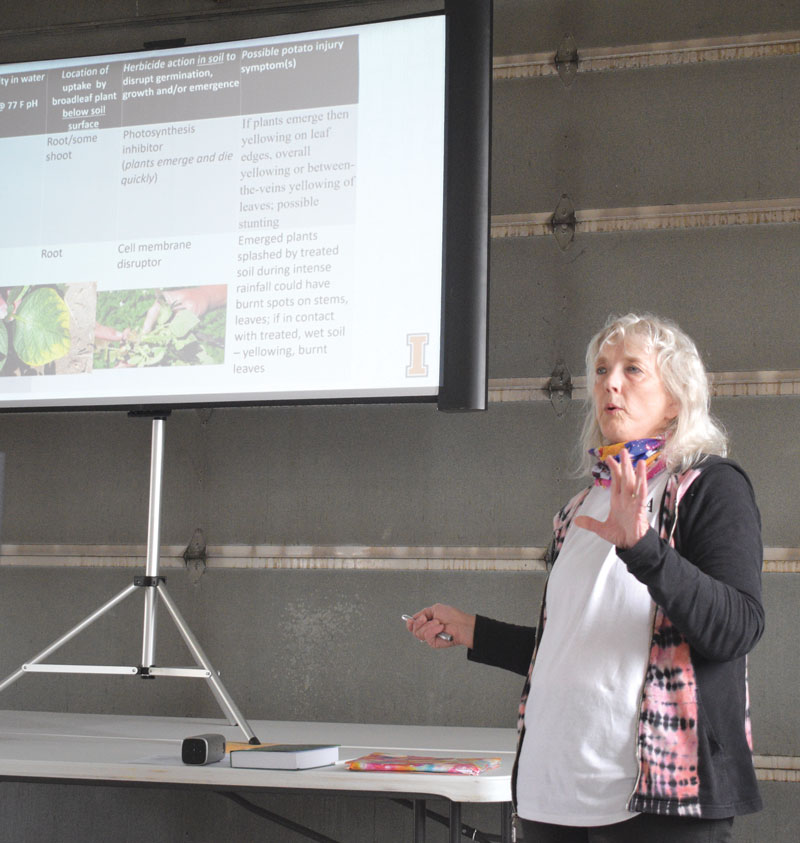Rain that made fields too muddy for field tours didn’t stop University of Idaho researchers from reporting on their latest herbicide trials during the Snake River Weed Management Tour, held June 30 at the Aberdeen Research and Extension Center.
Rainfall the day and evening prior left plots muddy. Rather than tooling around the field trials via pickup truck and trailer transport and trudging through the fields, Pam Hutchinson, a University of Idaho potato cropping systems weed scientist, turned the field day into a quasi-virtual tour. The research center farm crew drove the farm equipment out of the machine shop to make room for a big screen to project videos and PowerPoint presentations for the attendees, who were wearing face masks and social distancing.
As it turns out, Hutchinson was preparing to conduct a virtual tour the next week, so she was able to show attendees preliminary versions of trial treatment videos she had planned for the virtual tour. Hutchinson played a set of walkthroughs she had filmed during her planned weed control ratings conducted before row closure and added “real-time” commenting as each video ran its course.
Hutchinson says she has tried to turn the negative impacts of COVID-19 on her research and extension program into positive outcomes. She has been pleasantly surprised that conducting and participating in virtual Zoom meetings has expanded, rather than limited, her audience. Those that would not normally attend one of her presentations or tours in Aberdeen because of drive time, expenses, etc. have been able to see and hear her via Zoom.
Weed Control
One of the weed control research trial videos presented during the field day featured Zidua (pyroxasulfone), an herbicide recently labeled for use in potatoes. Tank mix treatments including Zidua were compared with mixtures including Outlook (dimethenamid-p) or Dual Magnum (s-metolachlor). All three of these herbicides are applied after potatoes are hilled but before potato emergence, and then sprinkler incorporated.
At the time the video was shot, Zidua was helping to control hairy nightshade, a problem weed for many potato growers. Outlook has the same mechanism of action (MOA) as Zidua and has at times provided better season-long control in Hutchinson’s trials. However, Zidua is not as soluble as Outlook, so it could be an alternative in coarse-textured, sandy soils. Outlook or Dual Magnum could potentially leach below the top 2 inches of a sandy soil where weed seeds are germinating and starting to grow.
The three herbicides’ MOA is inhibitory effects on the biosynthesis of very long chain fatty acids (VLCFAs). VLCFAs are essential for many plant structures such as cuticular waxes.
Potato Variety Herbicide Tolerance
Hutchinson also showed her walkthroughs of trials evaluating potato variety tolerance to sulfentrazone. Sulfentrazone is an herbicide applied preemergence to potatoes and can provide a high level of season-long hairy nightshade control.
As in the past, Russet Burbank and Ranger Russet tolerated rates as high as two times the recommended rate. In contrast, Shepody, a variety shown to be safe to sulfentrazone, was suffering from stunting and blackening/burning of the leaves in this 2020 trial. Hutchinson will repeat the trial in 2021 to determine if the variety tolerates sulfentrazone.
Effect of Excess Rainfall on Herbicide Injury to Potatoes
Excess rainfall has been the norm the past few years in southern Idaho. Last year, Hutchinson was called out to several potato fields where herbicide injury was suspect. In some places, rainfall in excess of 5 inches had occurred in the last two weeks of May. The objective behind this trial was to simulate that excess rainfall via irrigation and observe the injury symptoms from many of the herbicides labeled for use in potatoes. Visuals from the trial will allow for better investigation and determination of causes in grower fields.
As mentioned, some herbicides are more soluble than others. Soil moisture is needed for the herbicide to be available for uptake by weeds. Too much, and the herbicide is not in the right place at the right time to control weeds. Excess rainfall can also move herbicides down to the sprouts and roots of potatoes, and depending on the herbicide, injury can occur if potatoes cannot tolerate the herbicide at that time and place.
When simulating an excess of 6 inches rainfall within a two week period on top of normal irrigation in the trial this year, Hutchinson observed potato leaf malformation in the form of a drawstring effect seemingly caused by pre-emergence application of Outlook. Some of the same symptoms were seen last year in grower fields. As in the grower fields, potatoes recovered from the early injury in the rainfall simulation trial two to three weeks after symptoms were first seen.
To request a copy of Hutchinson’s field day handouts, including a tank mix partner choice chart and potato herbicide application timing table, email phutch@uidaho.edu.


